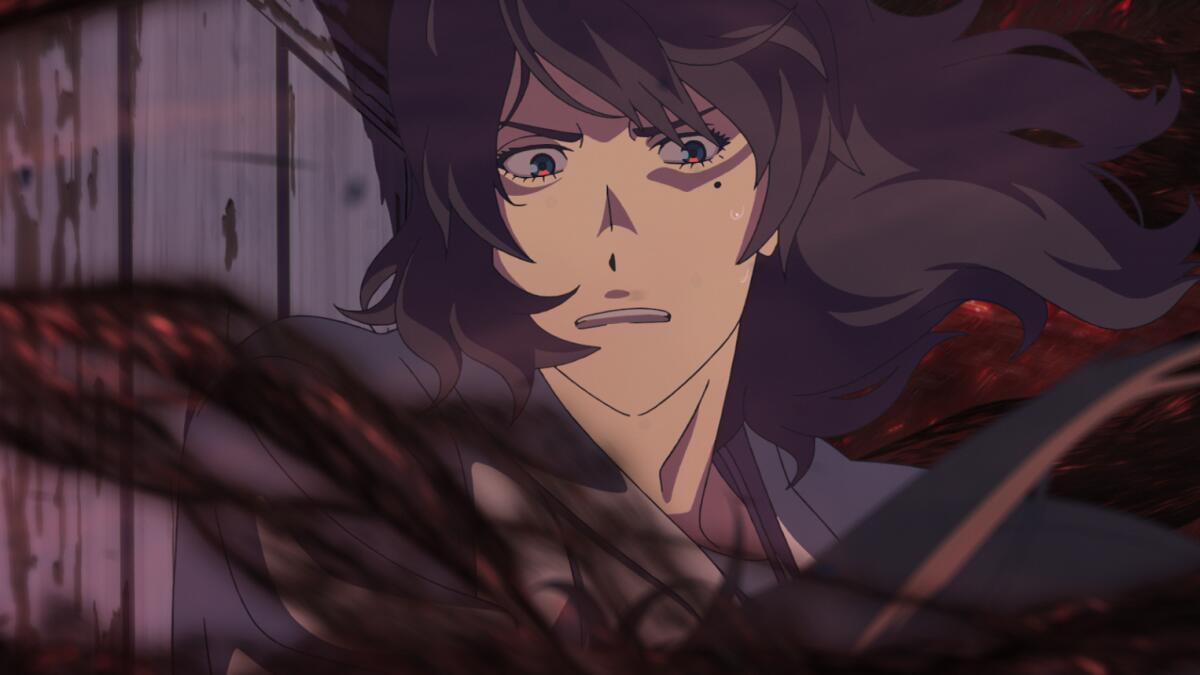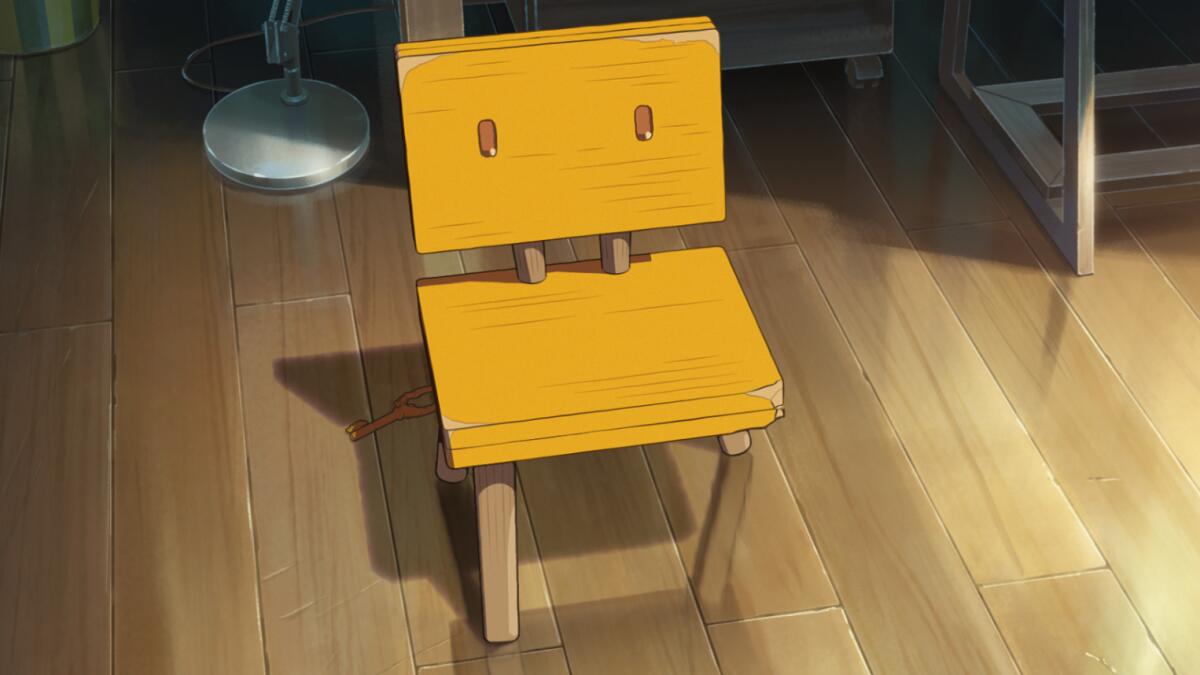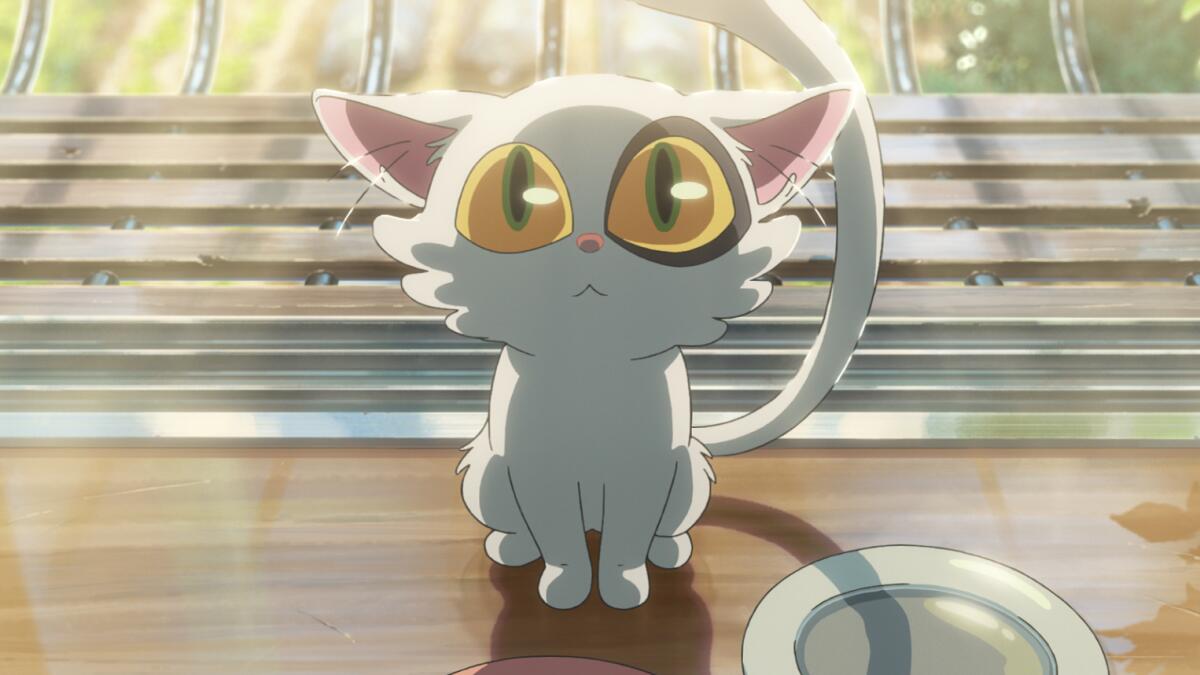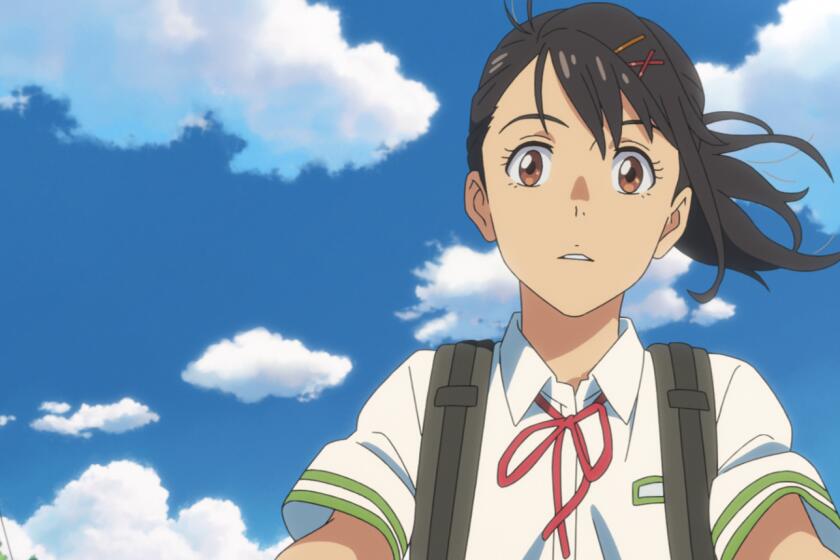An earthquake made Makoto Shinkai a disaster artist. Now he’s confronting it head-on

- Share via
Makoto Shinkai knows the 2011 Tōhoku earthquake changed him.
The Japanese filmmaker has been talking a lot about that catastrophic earthquake and its aftermath as he’s made the rounds promoting his latest anime feature, “Suzume,” out now in theaters, because it focuses on that disaster and what followed. But those familiar with Shinkai’s work know he’s been having a conversation about natural disasters through his films for years.
In an interview earlier this month during a visit to Los Angeles for the premiere of the film’s English-dubbed version, Shinkai carefully recounted how everybody’s life was disrupted that day 12 years ago, even in Tokyo, far away from the quake’s epicenter. Every time another early earthquake warning alert would set off cellphones, he would huddle with his wife and young daughter and wonder what was going to happen to Japan.
This latest anime fantasy from Japanese director Makoto Shinkai follows a 17-year-old girl on a journey to save Japan from imminent peril.
The earthquake and resulting tsunami led to disaster at the Fukushima power plant.
Only the passage of time enabled Shinkai to regain normalcy and purpose.
“I had always believed daily life in Japan would just continue forever, but the earthquake made me realize that it could all just abruptly end,” said Shinkai. “Because of that experience, I increasingly felt this desire to confront disasters and depict disasters in ways that can only be done in animation.”

In “Suzume,” which was released in Japan before an international premiere at the Berlin International Film Festival in February, Shinkai engages with the Tōhoku earthquake directly for the first time.
Seventeen-year-old Suzume is a survivor of the earthquake and subsequent tsunami who lost her mother to that disaster in northeastern Japan. Raised by her aunt, Suzume now lives in Kyushu, the most southwesterly of Japan’s main islands.
One day, after meeting a handsome stranger, Suzume stumbles upon a mysterious door among nearby ruins connected to a realm known as Ever-After. Unless these doors are properly sealed, a giant supernatural worm can burst through and cause massive earthquakes when it falls to the ground. Suzume sets off on a cross-country journey to help her new companion, Souta, close these doors, which can be found only in the ruins of abandoned places, until she eventually has to confront her own past back in her abandoned hometown.
“Suzume” boasts Shinkai’s signature: lush, naturalistic visuals paired with an approach to disasters that might be described as magical realism.
The opening scene of “Your Name.,” an animated epic of love, death, time and destiny from the Japanese writer-director Makoto Shinkai, traces the fiery arc of a comet as it streaks through the heavens and over a secluded stretch of countryside.
Although he had garnered acclaim for his previous works, Shinkai’s first global blockbuster was 2016’s “Your Name,” a body-swap romantic fantasy about two teenagers separated by time and space whose fates become intertwined because of an approaching comet. It broke a number of Japanese box office records and remains Shinkai’s biggest release to date. His follow-up, 2019’s “Weathering With You,” is another teen romance, this time about a boy and a girl trying to live life on their own terms in a Tokyo that is drowning in never-ending rain.
Shinkai’s success and commitment to the craft of original animated features has invited comparisons to Studio Ghibli’s great Hayao Miyazaki, even though their works are quite distinct.
With “Suzume,” Shinkai wanted to tone down the romance, so Souta, the handsome love interest, spends most of the film trapped in the form of a small yellow chair that is missing a leg. Featuring a walking, talking, three-legged chair (as well as a mischievous magical cat) was also intended to amp up the comedy of the film.
“Because this movie is based on the earthquake, there is a sadness to this story,” said Shinkai. “So I thought I should make it a more fun and comical movie in order to make sure people would come see it.”

According to Shinkai, his decision to make “Suzume’s” protagonist a girl was initially because in “Weathering With You” his protagonist was a boy. He believes “Suzume’s” story works regardless of the central character’s gender.
But when asked to consider how Suzume is a teenage girl whose journey involves encounters with a series of women, he takes a moment to reflect on his intentions. (That Shinkai takes his time to honestly engage with the questions he’s posed is likely among the reasons those who interview him are advised in advance to make each question count.)
“I was trying to think about who is really going to help you during a disaster,” said Shinkai. “I’m sure the government will help, of course. But I believe it’s the people that are right next to you — other individuals — that will be the ones who actually help you most.”
Shinkai explained that in Japan, women are still perceived as weaker in some ways and do not wield the same socioeconomic power as men. So the people Suzume encounters on her journey, such as a single mother of young children or the teenage daughter of a working-class family, are not those Japanese society would consider privileged or powerful.
“Looking back on it now, I think I wanted to show how Suzume is able to grow by forging connections with a series of people who could be considered powerless through her journey,” said Shinkai.
Makoto Shinkai’s masterful anime ‘Weathering With You,’ his first feature since ‘Your Name, ‘ is about a runaway boy and a weather-controlling girl in Tokyo.
He echoes this subtle bit of social commentary when he explains that one reason many of his characters have no parents or absent parents is because he is resistant to the idealization of two-parent households in Japan. Shinkai’s films may stand out for their fantasies, but they also reflect the everyday concerns of Japanese people.
Shinkai explained that “Suzume’s” giant, supernatural worm was inspired by Japanese mythology about a giant catfish that lived deep beneath Japan and caused earthquakes and other disasters when it moved underground.
“The idea that there is some sort of living creature underneath Japan is something I think Japanese people are familiar with,” said Shinkai. “Of course, we now understand the science behind earthquakes. But this was something people in the past believed, so I thought it was not only fair game to use a creature as an expression for earthquakes but that it made the symbolism more accessible.”

Among the reasons Shinkai specifically chose the form of a giant worm is the creature’s proximity to earth. “Worms ingest earth. They excrete earth. They make earth. Worms are basically earth,” he said.
Shinkai was also inspired by Haruki Murakami’s short story “Super-Frog Saves Tokyo,” which is about a giant talking frog, Kaeru-kun, that battles a giant earthquake-causing earthworm that lives in the ground under one of Tokyo’s wards.
It was important to Shinkai and the film’s crew, though, that “Suzume’s” worm could not be perceived as a creature or monster, like Godzilla. Instead, the worm was designed to resemble phenomena like smoke and rain and lava.
Living creatures “can appear to have thoughts and can be perceived as having some sort of will or purpose,” said Shinkai. “But earthquakes and natural disasters don’t have a purpose or a will, so I wanted to make sure the worm didn’t look like a monster or a creature.”
Shinkai started developing “Suzume” in early 2020, and he was working on the script when Japan declared a state of emergency in Tokyo and six other prefectures at the start of the COVID-19 pandemic. It only made him more committed to telling a story about the Tōhoku earthquake.
“What I first felt during the outbreak of the COVID-19 pandemic is a sense of crisis that this was going to further erode our memories of that earthquake from 12 years ago,” said Shinkai, who recognizes that he was not as negatively impacted by the pandemic as others. And his worry that the earthquake would be forgotten by people because of the pandemic spurred Shinkai to depict actual scenes of the aftermath of the Tōhoku earthquake and tsunami.
“I thought that if there was one thing a big animated movie could do, if animation could serve a societal purpose, it is to connect generations and bridge our generational memories.”
More to Read
Only good movies
Get the Indie Focus newsletter, Mark Olsen's weekly guide to the world of cinema.
You may occasionally receive promotional content from the Los Angeles Times.












